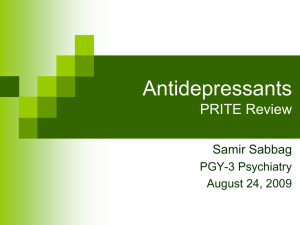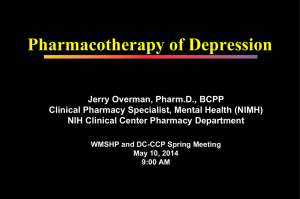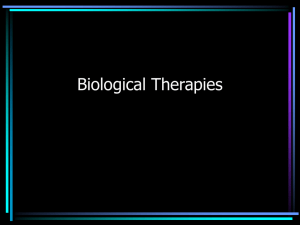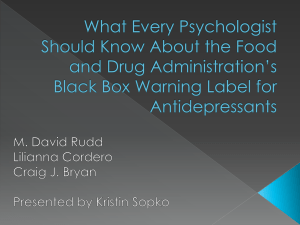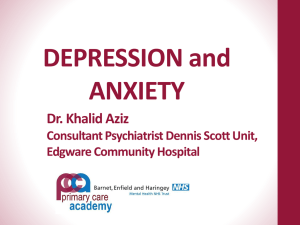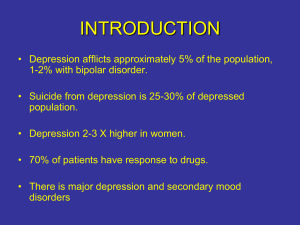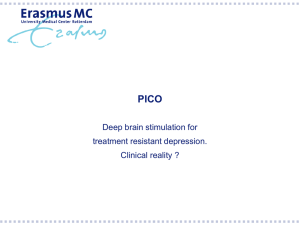Antidepresivi
advertisement
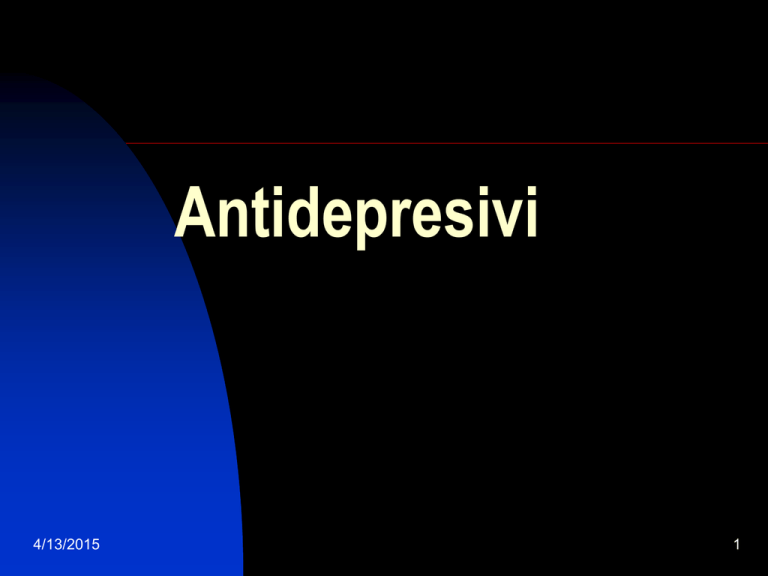
Antidepresivi 4/13/2015 1 Antidepresivi /upotreba 4/13/2015 depresija anksioznost Premenstrualni sindrom Bolni sindromi Poremećaj sna Poremećaj ishrane Odvikavanje od pušenja autizam 2 Diferencijalna dijagnoza depresije 4/13/2015 Bolesti tiroideje i paratiroideje anemija hipoksija maligniteti lijekovi demencija Parkinsonova bolest Obolenja jetre Cushing’s sindrom/ tretman steroidima 3 Lijekovi koji mogu uzrokovati simptome depresije Antihipertenzivi Kardiovaskularni lijekovi 4/13/2015 Corticosteroids, Progestins, (Estrogen) Analgetici Digitalis, Diuretics, Lidocaine, Procaine Steroidi Propanolol, Methyldopa, Reserpine, Clonidine, Hydralazine, Guanithidine Narcotics, Indomethacin Benzodiazepini antimicrobici, antipsihotici, hemoterapeutici, alkohol, etc 4 Lijekovi za depresiju 4/13/2015 Generalno, imaju podjednako djelovanje Odgovor kod 50 –80% pacijenata Velike individualne varijacije Placebo efekt 25-40% 5 Monoaminska hipotheza depresije Deficit jednog ili više biogenih amina Antidepresivi dovode do povećanja neurotransmitera u sinaptičkoj pukotini 4/13/2015 Serotonin (5-HT) Norepinefrin (NE) Dopamine (DA) Aktivacijom hemijskih glasnika (2nd messenger, interleukina, TNF) 6 7 4/13/2015 8 4/13/2015 9 4/13/2015 10 4/13/2015 11 4/13/2015 12 4/13/2015 13 4/13/2015 14 4/13/2015 15 Kratka istorija kasne 1950-te – MAOI i TCA efikasni “prljavi lijekovi” – mnogo NRL kasne 1980-te - SSRI kasne 1990-te 4/13/2015 atipični antidepresivi 16 Podijela antidepresiva 4/13/2015 Triciklični antidepresivi (TCA) Inhibitori monoamino-oksidaze (MAOI) Inhibitori ponovnog preuzimanja serotonina(SSRI) Inhibitori ponovnog preuzimanja serotonina i noradrenalina (SNRI) Antagonisti 5HT2 / inhibitori ponovnog preuzimanja (SARI) Noradrenalin i specifični serotonin antidepresivi (NaSSA) 17 Triciklični antidepresivi klomipramine (Anafranil) – sličan SSRI’s nortriptilin (Pamelor) – primarno adrenergički, najmanje ortost.hipotenz. imipramin (Tofranil) amitriptilin (Elavil) desipramin (Norpramin) – primarno adrenergički doksepin (Sinequan) protriptilin (Vivactil) maprotilin (Ludiomil)/heteroc. amoksapin (Ascendin) -- blago antipsihotičko djelovanje, rizik od TD, 4/13/2015 trimipramine (Surmontil) 18 TCA Jeftini i “prljavi” Često smrtni ishod kod predoziranja Zahtjevaju strogo praćenje pacijenata Mogu uzrokovati srčane smetnje (aritmije) Srčane NRL ograničavaju njihovu upotrebu Ekstenzivno se primjenjuju u primarnoj praksi za: 4/13/2015 Hronična bol, nesanica, profilaksa migrene, hronični umor 19 Triciklici – 5 lijekova u jednom Povećava nivo 5HT - SRI Povećava nivo NE - NRI M1 – antiholinergik, antimuskarinik suha usta,opstipacija, poremećaj vida,pospanost Alfa 1 – andrenergički antagonist vrtoglavica,ortostatska hipotenz., pospanost H 1 – antihistaminik porast TT, pospanost 4/13/2015 20 MAO inhibitori 4/13/2015 Inhibišu enzime (monoamino-oksidaze) koji razlažu 5-HT i NE povećava se nivo 5HT i NE Jeftini i djelotvorni mogu dovesti, ako se uzimaju istovremeno sa hranom koja sadrži tiramin ili nekim lijekovima do teških interakcija fenelzin (Nardil); tranilcipromin (Parnate) Dobri za atipičnu depresiju hiperfagija, hipersomnija, (pokušati prvo sa SSRI) 21 MAOI – mjere opreza 4/13/2015 Interakcije OTC dekongestivi, stimulansi CNS, antidepresivi, narkotici Dijeta bez tiramina sir, zrelo meso, proizvodi od pivskog kvasa, kiseli kupus, vino, Tiramin povećava oslobađanje NE Ako se ne pridržava dijete HT kriza potreban “washout period” poslije tretmana sa drugim antidepresivima a prije uvođenja MAOI (npr. 6 ned. nakon fluoksetina) izbjegavanje serotoninskog sindroma 22 Selektivni inhibitori preuzimanja serotonina (SSRI) 4/13/2015 U svijetu, široko propisivani Lijekovi prvog izbora Relativno sigurni i kod predoziranja Niska incidenca NRL Skupi 23 SSRI sertralin (Zoloft) fluoksetin (Prozac) citalopram (Celexa) paroksetin (Paxil) fluvoksamin (Luvox) Inhibišu CYP4501A2 – povećavaju konc. teofilina, olanzapina,kofeina Doziranje 2x dnevno 4/13/2015 24 SSRI 4/13/2015 Prozak(fluoxetin) – 20-40mg/dan Inhibits P4502D6, long t ½, most activating, appetite suppression Paxil(paroxetin) – 20-40mg/day Inhibits P4502D6, most sedating, more likely constipation Zoloft (sertralin)– 50-100mg/day (200mg) Less P450 inhibition, well tolerated, diarrhea, nausea Celexa(citalopram) – 20-40mg/day Minimal to no P450 inhibition, well tolerated in elderly and those with comorbid medical conditions25 SSRI – najčešće NR Seksualna disfunkcija (5HT2) Insomnija (5HT2) nemir/anksioznost (5HT2) glavobolje GI neželjeni efekti (5HT3) 4/13/2015 Veoma često(30-50%+) Smanjenje apetita, mučnina, dijareja, suha usta 26 Serotoninski sindrom 4/13/2015 Poremećaj termoregulacije Karakteriše se promjenama mentalnog statusa (konfuzija/hipomanija), porast temperature, groznica, agitacija, hiperrefleksija, drhtanje i tremor Javlja se rijetko,ali je često fatalan ishod uzrok – ekscesivna serotonergička stimulacija ? 27 Serotoninski sindrom Serotoninski sindrom se javlja ako se SSRI kombinuju sa MAO inhibitorima fenelzin, tranilcipromin MAOI (selektivni) Selegilin (MAO-B), moklobemid (reverzibilni) 4/13/2015 Triptofan (serotonin prekursor) 30 Serotonergički lijekovi prekursori serotonina S–adenyl–L–methionine L–tryptophan 5–hydroxytryptophan dopamine Serotonergički lijekovi Inhibitori preuzimanja serotonina citalopram, fluoxetine, fluvoxamine, paroxetine, sertraline, venlafaxine clomipramine, imipramine nefazodone, trazodone chlorpheniramine cocaine, dextromethorphan, pentazocine, pethidine, tramadol Serotonergički lijekovi Agonisti serotonina fenfluramine, p–chloramphetamine bromocriptine, dihydroergotamine, gepirone sumatriptan buspirone, ipsapirone eltoprazin, quipazine Serotonergički lijekovi Inhibitori monoamino oksidaze (MAOIs) clorgyline, isocarboxazid, nialamide, pargyline, phenelzine, tranylcypromine selegiline furazolidone procarbazine Serotonergički lijekovi Reverzibilni inhibitori MAO brofaramine befloxatone, toloxatone moclobemide Tretman Suportivne mjere Kontrola simptoma kontrola temperature Adekvatna ventilacija 5–HT2A antagonisti idealni sigurni efikasni dostupni 5–HT2A antagonisti Cyproheptadine Chlorpromazine Chlorprothixene Haloperidol Clozapine Risperidone Olanzapine Sertindole Methysergide Ketanserin 100 71 233 2.8 62 170 25 260 14 178 Affinity at 5-HT2 = 10-7 x 1/Kd Kapur, S et al. (1997). Cyproheptadine: a potent in vivo serotonin antagonist. American Journal of Psychiatry, 154, 884 4/13/2015 38 4/13/2015 39 4/13/2015 40 4/13/2015 41 4/13/2015 42 4/13/2015 43 Additional Antidepressants SSRIs, TCAs, and MAOIs easily classified Remainder less easily classified 4/13/2015 “atypical antidepressants” Mechanisms listed for your understanding Clinical points more important than mechanisms 44 Venlafaxine (Effexor) 4/13/2015 Increases 5HT & NE - A Serotonin and NE Reuptake Inhibitor (SNRIs) Low dose only 5HT reuptake inhibition Med-High dose both 5HT & NE reuptake blockade Very high doses – 3 monoamines blocked 5HT, NE, DA (minor) Minimal P450 Inhibition 45 Venlafaxine, cont’d Dose range 18.75-375mg/day May work faster than others SEs like SSRIs Wierd withdrawal symptoms – reg release has very short t ½ 4/13/2015 Sustained release available – QD dosing 46 Nefazodone (Serzone) Increases 5HT & NE NE & 5HT reuptake inhibition (therapeutic effect) Also 5HT2 receptor blockade (most powerful effect) 5HT2 blockade sedation Alpha 1 blockage dizzy (NE reuptake tends to counter this) 4/13/2015 47 Nefazodone, cont’d Less sexual SEs (at low doses) Less activating (prob 2nd to < 5HT reuptake activity vs SSRIs) Good for agitated depression Potent P4503A4 Inhibitor – metabolizes alprazolam (xanax) levels can double; arrhythmias can occur if combined with terfenadine, cisapride, astemizole 4/13/2015 Rare cases of hepatic failure have occurred—check baseline lft’s 48 Nefazodone, cont’d Usual dose 300-600mg/day Side effects Somnolence (5HT2 blockade) dry mouth (NE effect) Nausea (serotonergic effect) Constipation (NE effect) visual phenomena 4/13/2015 49 Trazodone 5HT2 blockade sedation Little SSRI action Very sedating – often used for insomnia (potent 5HT2 blocker) Potent blocker alpha 1 orthostasis Antihistamine activity -- sedation No NE reuptake inhibition Unlikely significant drug-drug interactions Priapism rare (1/10,000) side effect – need to mention (mech may be r/t both alpha – 1 and 5HT2 blockage) 4/13/2015 50 Blocking 5HT2 Receptors 4/13/2015 Sedation Enhance slow wave sleep Decrease anxiety No sexual dysfunction 51 Bupropion (Wellbutrin) Increases NE & DA via NE and DA reuptake inhibition Dose range 150-300mg/day (max 450) 4/13/2015 Can lower seizure threshold – contraindicated in pts w sz d/o, edo Less sexual dysfunction (NE effect) Split doses bid – at least 8 hrs apart Max 150mg RR/ 200mg SR per dose 52 Bupropion (Wellbutrin) Exact mechanism unclear Response may be more r/t metabolite than parent drug 4/13/2015 Possible higher bld levels if used w/SSRI w/P450 enzyme inhibition 53 Mirtazapine (Remeron) Increases NE & 5HT Blocks some 5HT receptors thus called a NE and specific 5HT antidepressant (NaSSA) Four principal actions Alpha 2 blockade increases NE leads to subsequent increase 5HT 4/13/2015 increase NE takes “brakes” off 5HT transmission Less sexual s/e’s (5HT2 blockade/NE) Less GI s/e’s ( 5HT3 blockade) Weight gain/sedation antihistamine effect 54 Mirtazapine (Remeron) 4/13/2015 Unique mechanism action Only dual action drug that enhances both NE and 5HT and does so by blocking alpha 2 receptors rather than by blockade of NE reuptake pump Takes advantage of unique interactions between NE and 5HT Promotes sleep pattern that is most like physiologically normal sleep 55 Antidepressant Management Minimal trial 6-8 weeks Goal = remission Response = 50% improvement Remission = no symptoms 4/13/2015 Less risk relapse w/ remission Move toward combination drugs to achieve remission Continue for 16-20 wks after remission (preferably longer, i.e. 6-12 mos) 56 How Long to Treat? Single episode Recurrent episode or chronic depression 4/13/2015 Treat 6-12 months, best chance sustained remission if Tx 1 yr Treatment is usually for years 57 Maintenance Treatment Importance of maintenance tx: > 50% will have at least one lifetime recurrence 4/13/2015 Usually within 2-3 years If > 2 episodes, risk for another approaches 90% 58 Lack of Response 4/13/2015 Correct diagnosis? Comorbid conditions? Optimize dosage 30-40% fail to achieve adequate response 59 Strategies for Failure to Respond Initial Tx Augmentation Lithium, Wellbutrin, thyroid, stimulant, other antidepressant in combination, Pindolol (questionable efficacy) Switch Medication Different class 30-50% may respond to alternative SSRI 4/13/2015 60 Key Points 1st Line Tx SSRI F/U 4 weeks No/Minimal response, mild SEs Increase dose Mod improvement cont same dose No/Mild improvement, significant SEs 4/13/2015 Alternative SSRI Change class – e.g. Wellbutrin, Effexor, Atypical (Serzone, Mirtazipine), TCA (if not contraindicated) 61 Discontinuing Medication Taper over several weeks enables detection of reemergence of symptoms avoids discontinuation syndromes 4/13/2015 Educate about risks and symptoms of relapse 62 SSRI Withdrawal Syndrome More common SSRIs w/shorter t ½ life Symptoms Flu-like symptoms Peak day 5, can last up 3 weeks Can mimic anxiety/depression 4/13/2015 Resolves within 24 hrs restarting SSRI Avoid with slow taper of drug 63 Common Misconceptions “Antidepressants are addictive” “Antidepressants are mind-altering drugs” “Antidepressants are uppers” “Once I’m better, I don’t need medication anymore” Reference for patients 4/13/2015 Prozac and the New Antidepressants, revised ed: What you need to know about Prozac, Zoloft, Paxil, etc By William Appelton, MD 65 Improving Compliance 4/13/2015 Educate when and how to take meds Delay in response – 2-4 wks Continue meds even if better Consult w/ Dr before discontinuing Educate family Simplify regimen Effective communication (Listen!) Medication assistance if $$ issue Side effects and complicated dosing regimen can lead to noncompliance 66 Strategies to Manage S/E’s Watch and wait (if no immediate medical risk) Alter dosage, frequency, timing of administration – (SSRI sedation change hs dosing) 4/13/2015 Provide specific treatment for SEs Consider switching medication 67 MDD with Psychotic Features 4/13/2015 Greater risk for suicide (consider hospitalization) Treat with both antidepressant and antipsychotic ECT can be used as first line treatment 68 MDD with Catatonic Features Clinical features (any of following) 4/13/2015 Motoric immobility (I.e. catalepsy or stupor) Extreme agitation Extreme negativism Peculiarities of voluntary movement Echolalia or echopraxia Benzodiazepines can show immediate relief ECT can be used as first-line 69 MDD with Atypical Features Clinical features (any of following) Increased sleep Increased appetite and/or wt gain Marked mood reactivity Sensitivity to emotional rejection Severe fatigue (leaden paralysis) 4/13/2015 SSRIs, MAOIs, (possibly bupropion) 70 Antidepressants and Pregnancy Carefully consider risk vs benefit Untreated depression can affect prenatal care No known birth defects, but still caution SSRIs are current drugs of choice 4/13/2015 most info on Prozac – slight increased risk minor anomalies; no > risk major malformations ECT effective and safe alternative 71 Electroconvulsive Therapy (ECT) 4/13/2015 Most effective and rapid treatment for depression (70-80% response rate) Introduced in Italy in 1938, one of the oldest medical treatments in regular use today Exact mechanism of action remains unclear 72 ECT, cont’d 4/13/2015 Surgical procedure Electrical stimulus applied to temporal region (unilateral associated with less cognitive impairment) to induce seizure Brief pulsating current, comparable to a 20-watt light bulb (pulsation also decreases cognitive impairment) 73 ECT, cont’d 4/13/2015 Pts usually receive treatments 3/wk Series usually 6-12 treatments, mean 9 S/E’s: brief alteration in blood pressure, pulse, cardiac rhythm; fx’s in past (now use succinylcholine); post-ictal confusion; anterograde amnesia 74 Indications for ECT 4/13/2015 Medication refractory depression Suicidal depression Depression accompanied by refusal to eat/take fluids Depression during pregnancy H/o positive response to ECT Catatonic syndromes Acute forms of schizophrenia Mania unresponsive to medication Psychotic or melancholic depression unresponsive to medication 75 Additional Important Therapies, FYI 4/13/2015 Psychotherapy Seasonal Affective Disorder Alternative Therapies 76 Medications vs Psychotherapy No illness occurs in a vacuum Mild-Moderate MDD – one or both appropriate much influenced by pt preference, Hx, and prior response Moderate-Severe MDD Medication indicated Psychotherapy adjunct Consider ECT 4/13/2015 77 Features Favoring Psychotherapy Significant psychosocial stressors Interpersonal difficulties Comorbid Axis II Disorders Poor medication compliance Patient preference Competent providers 4/13/2015 Data support efficacy of two types therapy – cognitive and interpersonal 78 Types of Psychotherapy Cognitive-Behavioral Interpersonal Therapy Focus on interpersonal relationships, interaction style, social skills, losses, role transitions Psychodynamic Psychotherapy 4/13/2015 Challenges irrational beliefs/ behaviors and distorted thinking that contribute to depressed mood Intrapsychic conflict, defense mechanisms, repression Less data, usually longer term 79 Seasonal Affective Disorder Assess for seasonal component Symptoms arrive winter, vanish in spring More common women – 4:1 More common northern climates 4/13/2015 Sarasota, FL – 8.9%; Nashua, NH – 30% Decreased daylength increase in melatonin ? Decrease serotonin 80 Seasonal Affective Disorder Full spectrum lighting Intensity is important 10,000 Lux – 30min – 2 hr in am 80% improve Timing of Tx can phase advance or delay body’s biological clock affects sleep patterns, body temperature, hormone secretion 4/13/2015 Changes in physiological functions may be basis of therapeutic effect 81 Herbal Therapies 4/13/2015 Melatonin for sleep disorders St. John’s Wort for depression Ginko bilboa for dementia Omega-3 Fatty Acids for mood disorders S- adenylmethionine (SAMe) for depression Feverfew for migraine prophylaxis Garlic for cholesterol lowering effects 82 Herbal Therapies Not FDA regulated St. John’s Wort most studied 4/13/2015 No guarantee purity or standardization www.ConsumerLab.com - reputable testing of products www.NaturalDatabase.com - great resource on natural medicines Beneficial mild-moderate depression when compared placebo or TCAs Doses up to 900mg/day x 6 wks rcmd GI s/e’s, sedation 83 Omega-3 Fatty Acids Higher blood levels correlate with significantly lower incidence of depression in general population and postpartum depression Potential mood stabilization properties – BPAD studies Studies in Schizophrenic and ADHD populations The Omega Connection 4/13/2015 Dr. Andrew Stoll 84 When to Refer to Psychiatry 4/13/2015 Failure to respond to 1 or more trials of SSRI Concerned about safety – suicidal or homicidal ideation Psychotic symptoms/ loss of reality Inability to perform ADLs Gut instinct – something not right 85 Summary Depression is highly prevalent, underdiagnosed and under-treated Highly treatable You will prescribe antidepressants frequently Keys to Treatment 4/13/2015 Detection Adequate treatment – minimum 6-12 months Therapy if indicated Patient and Family education 86 References Psychopharmacology of Antidepressants Introductory Textbook of Psychiatry 4/13/2015 Dr. Stephen M. Stahl, MD, PhD Nancy C. Andreasen, MD, PhD and Donald W. Black, MD 87
